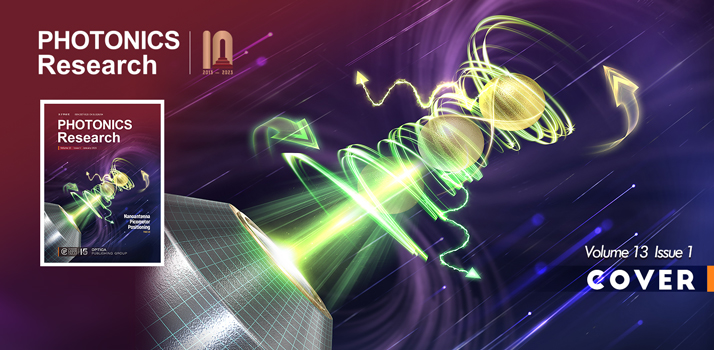Search by keywords or author

Quantum Optics
Xin Wang, Tianze Sheng, and Yuan Sun
Photonics Research
- Apr. 03, 2025
- Vol. 13, Issue 4 (2025)
Optoelectronics
Wenyu Kang, Shilin Liu, Xiaofang Ye, Yang Chen... and Junyong Kang|Show fewer author(s)
Photonics Research
- Apr. 03, 2025
- Vol. 13, Issue 4 (2025)
Instrumentation and Measurements
Zijie Liu, Zhiyang Wang, Xiaomin Qin, Xiaolei Guan... and Jingbiao Chen|Show fewer author(s)
Photonics Research
- Apr. 03, 2025
- Vol. 13, Issue 4 (2025)
Quantum Optics
Zhiyun Shu, Yuchi Li, Xiaoyu Liu, Hailong Han... and Hao Li|Show fewer author(s)
Photonics Research
- Apr. 03, 2025
- Vol. 13, Issue 4 (2025)
Optoelectronics
Xiaoqiuyan Zhang, Sunchao Huang, Tianyu Zhang, Yuxuan Zhuang... and Min Hu|Show fewer author(s)
Photonics Research
- Apr. 01, 2025
- Vol. 13, Issue 4 (2025)
Editors' Picks
Integrated optical frequency combs, as a key technology in modern photonics, have attracted significant attention in recent years due to their high-dimensional modal properties in the time and frequency domains. This technology has demonstrated remarkable applications in classical optics, such as high-capacity communication, spectral analysis, and ultrafast ranging, while also enabling unprecedented capabilities for the generation and manipulation of high-dimensional quantum states in quantum op
Photonics Research
- Mar. 24, 2025
- Vol. 13, Issue 1 (2025)
Editors' Picks
Multiplexing technology, as a means to effectively enhance information storage and transmission capabilities, has always been of great interest. Traditional multiplexing techniques, such as angular multiplexing, positional multiplexing, orbital angular momentum multiplexing, and polarization multiplexing, hold significant importance in information storage and transmission. However, when exploring multiplexing technologies across various dimensions, the polarization dimension faces challenges due
Photonics Research
- Mar. 24, 2025
- Vol. 13, Issue 2 (2025)
Editors' Picks
Quantitative phase imaging (QPI) is an optical microscopy technique that quantifies the morphology and refractive index distribution of a sample by measuring the phase shift of light waves passing through it, without the need for dyes or labels. With its non-invasive and highly sensitive nature, it has found wide applications in biomedicine, materials science, and other fields. Compared to traditional intensity imaging techniques, QPI provides more structural information and is particularly suit
Photonics Research
- Mar. 18, 2025
- Vol. 13, Issue 1 (2025)
On the Cover
Nanoantennas, as miniature optical devices, have garnered significant attention due to their immense potential in fields such as super-resolution imaging, surface-enhanced Raman spectroscopy, and quantum sensing. However, because nanoantennas are much smaller than the wavelength of light—typically below the diffraction limit—precise positioning and manipulation of these nanoantennas remain urgent challenges. Traditional positioning techniques are constrained by the optical diffraction limit, mak
Photonics Research
- Mar. 18, 2025
- Vol. 13, Issue 1 (2025)
Top Downloads
- Photonics Research
- Vol. 12, Issue 12, 2948 (2024)
- Photonics Research
- Vol. 12, Issue 12, 2772 (2024)
- Photonics Research
- Vol. 12, Issue 11, A69 (2024)
- Photonics Research
- Vol. 12, Issue 5, 1016 (2024)
- Photonics Research
- Vol. 12, Issue 8, A63 (2024)
- Photonics Research
- Vol. 12, Issue 10, 2207 (2024)
Submission Open:1 June 2025
Submission Deadline: 1 August 2025
Editor (s): Andrew Forbes, Haoran Ren, Lixiang Chen, Yijie Shen, Takashige Omatsu
Submission Open:15 January 2025
Submission Deadline: 30 April 2025
Editor (s): Nunzio Cennamo, Olivier Soppera, Giuseppe D’Aguanno, Yang Zhao
















